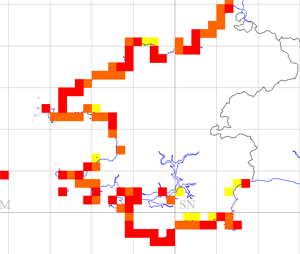Rock Pipits breed all around the rocky open coast on mainland Pembrokeshire, and on the offshore islands, including Grassholm, some 12 miles west of the mainland, where they nest on/in cliff faces. They also occur within the sheltered Milford Haven Waterway, on rocky shores backed by cliffs.
The data from the 2003-07 tetrad survey suggest that, although the Rock Pipit remains a common breeding resident on the islands and mainland coast, there have been changes in the distribution of breeding pairs, and probably in the overall number of pairs.
The data indicate that Rock Pipits have disappeared from 20 tetrads in which they were recorded as confirmed breeding in the 1984-88 tetrad survey, which represents a 9% rate of decline. On the other hand, there was a significant increase, an almost doubling, of the number of tetrads where Rock Pipits were recorded as “probable breeding”.
A look at the tetrad map confirms that Rock Pipits have disappeared as a breeding species from the upper Daugleddau Estuary, much of the inner and outer sections of the Milford Haven Waterway, and from the open coast in the Amroth/Wisemans Bridge/Saundersfoot area. Elsewhere on the coast, it is worth noting that several of the tetrads where Rock Pipits were recorded as probable breeding coincide with parts of the coast that are particularly difficult to survey from the cliff tops. Observers may have erred on the side of caution because they were unable to obtain sufficient evidence to confirm breeding in these tetrads. If this is the case, then it is likely that the distribution of the breeding population on most of the outer coast remained stable between the two tetrad surveys.
In terms of the size of the breeding population, the situation is less clear. The Pembrokeshire Bird Report for 2003 notes that there were 30 territories occupied by Rock Pipits on Skokholm Island. A comparison between this and the figure of 41 occupied territories quoted for Skokholm Island in 1990 suggests a decline of up to 27% in breeding Rock Pipits on the island during that period.
Reasons for the decline recorded on Skokholm Island are not immediately obvious, although a lack of insect food at critical stages in the breeding cycle, perhaps resulting from poor weather may be a factor, and it may not be representative of the population as a whole. A 9% decline in the number of tetrads in which breeding was confirmed between the two tetrad surveys, however, would put the total population at around 900 pairs.
Jane Hodges

Fieldwork 2003-07 (based on 490 tetrads)
Red = breeding confirmed = 51
Orange = breeding probable = 40
Yellow = breeding possible = 11
Total tetrads in which registered = 102 (20.8%)
 Thursday, August 1, 2013 at 8:14AM
Thursday, August 1, 2013 at 8:14AM  1949 BoP in
1949 BoP in  Rock Pipit
Rock Pipit 





